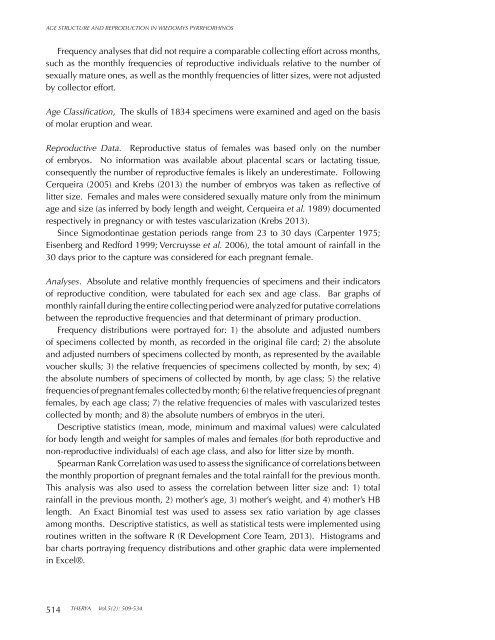therya-5_2
therya-5_2
therya-5_2
Create successful ePaper yourself
Turn your PDF publications into a flip-book with our unique Google optimized e-Paper software.
AGE STRUCTURE AND REPRODUCTION IN WIEDOMYS PYRRHORHINOS<br />
Frequency analyses that did not require a comparable collecting effort across months,<br />
such as the monthly frequencies of reproductive individuals relative to the number of<br />
sexually mature ones, as well as the monthly frequencies of litter sizes, were not adjusted<br />
by collector effort.<br />
Age Classification, The skulls of 1834 specimens were examined and aged on the basis<br />
of molar eruption and wear.<br />
Reproductive Data. Reproductive status of females was based only on the number<br />
of embryos. No information was available about placental scars or lactating tissue,<br />
consequently the number of reproductive females is likely an underestimate. Following<br />
Cerqueira (2005) and Krebs (2013) the number of embryos was taken as reflective of<br />
litter size. Females and males were considered sexually mature only from the minimum<br />
age and size (as inferred by body length and weight, Cerqueira et al. 1989) documented<br />
respectively in pregnancy or with testes vascularization (Krebs 2013).<br />
Since Sigmodontinae gestation periods range from 23 to 30 days (Carpenter 1975;<br />
Eisenberg and Redford 1999; Vercruysse et al. 2006), the total amount of rainfall in the<br />
30 days prior to the capture was considered for each pregnant female.<br />
Analyses. Absolute and relative monthly frequencies of specimens and their indicators<br />
of reproductive condition, were tabulated for each sex and age class. Bar graphs of<br />
monthly rainfall during the entire collecting period were analyzed for putative correlations<br />
between the reproductive frequencies and that determinant of primary production.<br />
Frequency distributions were portrayed for: 1) the absolute and adjusted numbers<br />
of specimens collected by month, as recorded in the original file card; 2) the absolute<br />
and adjusted numbers of specimens collected by month, as represented by the available<br />
voucher skulls; 3) the relative frequencies of specimens collected by month, by sex; 4)<br />
the absolute numbers of specimens of collected by month, by age class; 5) the relative<br />
frequencies of pregnant females collected by month; 6) the relative frequencies of pregnant<br />
females, by each age class; 7) the relative frequencies of males with vascularized testes<br />
collected by month; and 8) the absolute numbers of embryos in the uteri.<br />
Descriptive statistics (mean, mode, minimum and maximal values) were calculated<br />
for body length and weight for samples of males and females (for both reproductive and<br />
non-reproductive individuals) of each age class, and also for litter size by month.<br />
Spearman Rank Correlation was used to assess the significance of correlations between<br />
the monthly proportion of pregnant females and the total rainfall for the previous month.<br />
This analysis was also used to assess the correlation between litter size and: 1) total<br />
rainfall in the previous month, 2) mother’s age, 3) mother’s weight, and 4) mother’s HB<br />
length. An Exact Binomial test was used to assess sex ratio variation by age classes<br />
among months. Descriptive statistics, as well as statistical tests were implemented using<br />
routines written in the software R (R Development Core Team, 2013). Histograms and<br />
bar charts portraying frequency distributions and other graphic data were implemented<br />
in Excel®.<br />
514<br />
THERYA Vol.5(2): 509-534



